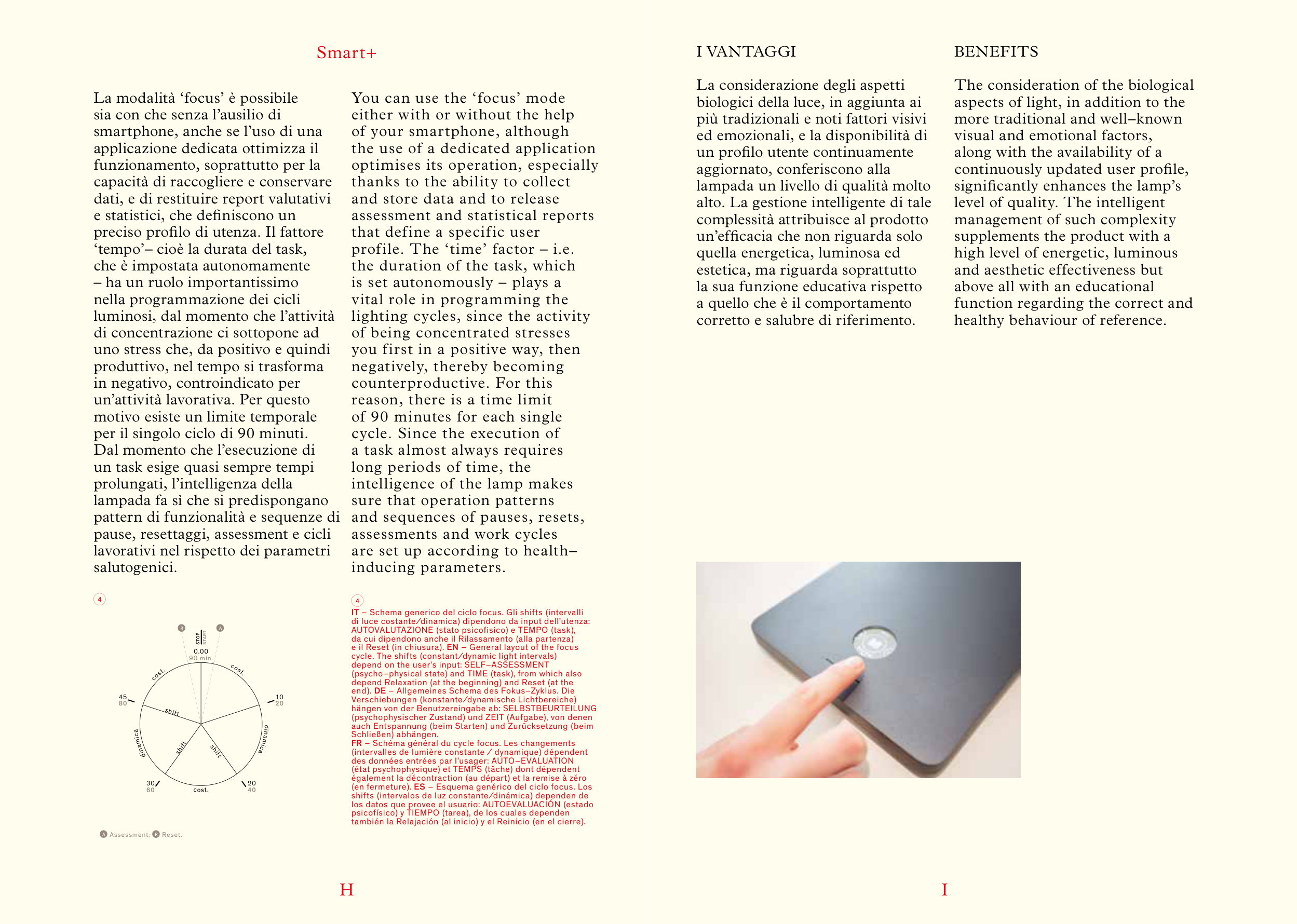I VANTAGGI
La considerazione degli aspetti
biologici della luce, in aggiunta ai
più tradizionali e noti fattori visivi
ed emozionali, e la disponibilità di
un profilo utente continuamente
aggiornato, conferiscono alla
lampada un livello di qualità molto
alto. La gestione intelligente di tale
complessità attribuisce al prodotto
un’efficacia che non riguarda solo
quella energetica, luminosa ed
estetica, ma riguarda soprattutto
la sua funzione educativa rispetto
a quello che è il comportamento
corretto e salubre di riferimento.
BENEFITS
The consideration of the biological
aspects of light, in addition to the
more traditional and well–known
visual and emotional factors,
along with the availability of a
continuously updated user profile,
significantly enhances the lamp’s
level of quality. The intelligent
management of such complexity
supplements the product with a
high level of energetic, luminous
and aesthetic effectiveness but
above all with an educational
function regarding the correct and
healthy behaviour of reference.
I
Smart+
H
La modalità ‘focus’ è possibile
sia con che senza l’ausilio di
smartphone, anche se l’uso di una
applicazione dedicata ottimizza il
funzionamento, soprattutto per la
capacità di raccogliere e conservare
dati, e di restituire report valutativi
e statistici, che definiscono un
preciso profilo di utenza. Il fattore
‘tempo’– cioè la durata del task,
che è impostata autonomamente
– ha un ruolo importantissimo
nella programmazione dei cicli
luminosi, dal momento che l’attività
di concentrazione ci sottopone ad
uno stress che, da positivo e quindi
produttivo, nel tempo si trasforma
in negativo, controindicato per
un’attività lavorativa. Per questo
motivo esiste un limite temporale
per il singolo ciclo di 90 minuti.
Dal momento che l’esecuzione di
un task esige quasi sempre tempi
prolungati, l’intelligenza della
lampada fa sì che si predispongano
pattern di funzionalità e sequenze di
pause, resettaggi, assessment e cicli
lavorativi nel rispetto dei parametri
salutogenici.
You can use the ‘focus’ mode
either with or without the help
of your smartphone, although
the use of a dedicated application
optimises its operation, especially
thanks to the ability to collect
and store data and to release
assessment and statistical reports
that define a specific user
profile. The ‘time’ factor – i.e.
the duration of the task, which
is set autonomously – plays a
vital role in programming the
lighting cycles, since the activity
of being concentrated stresses
you first in a positive way, then
negatively, thereby becoming
counterproductive. For this
reason, there is a time limit
of 90 minutes for each single
cycle. Since the execution of
a task almost always requires
long periods of time, the
intelligence of the lamp makes
sure that operation patterns
and sequences of pauses, resets,
assessments and work cycles
are set up according to health–
inducing parameters.
4
IT – Schema generico del ciclo focus. Gli shifts (intervalli
di luce costante⁄dinamica) dipendono da input dell’utenza:
AUTOVALUTAZIONE (stato psicofisico) e TEMPO (task),
da cui dipendono anche il Rilassamento (alla partenza)
e il Reset (in chiusura). EN – General layout of the focus
cycle. The shifts (constant⁄dynamic light intervals)
depend on the user’s input: SELF–ASSESSMENT
(psycho–physical state) and TIME (task), from which also
depend Relaxation (at the beginning) and Reset (at the
end). DE – Allgemeines Schema des Fokus–Zyklus. Die
Verschiebungen (konstante⁄dynamische Lichtbereiche)
hängen von der Benutzereingabe ab: SELBSTBEURTEILUNG
(psychophysischer Zustand) und ZEIT (Aufgabe), von denen
auch Entspannung (beim Starten) und Zurücksetzung (beim
Schließen) abhängen.
FR – Schéma général du cycle focus. Les changements
(intervalles de lumière constante ⁄ dynamique) dépendent
des données entrées par l’usager: AUTO–EVALUATION
(état psychophysique) et TEMPS (tâche) dont dépendent
également la décontraction (au départ) et la remise à zéro
(en fermeture). ES – Esquema genérico del ciclo focus. Los
shifts (intervalos de luz constante⁄dinámica) dependen de
los datos que provee el usuario: AUTOEVALUACIÓN (estado
psicofísico) y TIEMPO (tarea), de los cuales dependen
también la Relajación (al inicio) y el Reinicio (en el cierre).
4
A Assessment; R Reset.
R
A
d
i
n
a
m
i
c
a
d
i
n
a
m
i
c
a
c
o
st
.
shift
shift
shift
45
80
STOP
START
0.00
90 min.
30
60
10
20
20
40
c
o
s
t.
c
o
s
t
.


